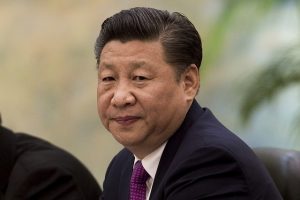The leaders of America and China — the world’s two largest economies — meet today and tomorrow, and the advance choreography has been confusing. Donald Trump will host Xi Jingping at his Florida club, but the only certainty is the two men won’t play golf, something frowned on in China and banned for millions of Communist Party members.
Everything else is up in the air, especially as Mr Trump continues to glower at the Chinese, via Twitter, for the trade imbalance and North Korea’s increasing bellicosity.
The uncertainty is compounded by a sense that the United States and China are awkwardly trying to ease into each other’s space — Mr Trump’s America away from the international order it has led from 1945; and China signalling that it will shoulder more of that burden. Unlike past summits, the mood music, too, is different. This time it is the Americans who are singing the blues about the international rules that govern trade and even about carbon dioxide emissions; China is resolutely backing them. Led by Mr Trump, an inexperienced politician with a tendency to angry outbursts, the US appears less steady and reliable for anxious allies than Mr Xi’s China.
Is it time then to take seriously the so-called “China solution”, a phrase Mr Xi first used last year to assure the world that China has a fix for everything? The Chinese people, he said, are “fully confident that they can provide a China solution to humanity’s search for better social institutions.” It was a vague prospectus and certainly much less well-defined than America’s decades-old message to the world — that it will act in the defence of freedom, liberty, free trade, democracy and human rights. He said it in July when the US presidential election still seemed to be Hillary Clinton’s to lose. No one but the Chinese took it seriously at the time but now, with Mr Trump in the White House, things have changed.
America once sold dreams, now China wants to sell solutions. Might this be the very template for a world, disrupted east and west by change, and seeking a quick fix?
What might a “China solution” mean anyway? First, the status quo on globalisation, with China possibly investing more, if strategically, overseas, especially in the US. This would accelerate a process well in train for the past five years with China as among the top three export markets for 33 US states as the result of piecemeal deals.
At this year’s World Economic Forum in Davos, Mr Xi delivered a paean to global economic engagement, suggested that China should “guide economic globalisation” and that it would welcome everyone aboard “the express train of Chinese development”. For the US, a China solution could take the form of financial investments that would create jobs. It would be a politically astute offer that Mr Trump could tout domestically as a triumph of his negotiating skills. In January, Ding Xuedong, the chairman of the sovereign wealth fund that manages part of China’s foreign exchange reserves, hinted as much when he put a price on Mr Trump’s infrastructure plan. It would need at least $8 trillion (Dh29tn), he said, and probably the help of overseas investors.
Second, a “China solution” would seek to maintain the status quo on current climate change policies agreed in Paris. They have been officially signed by more than a hundred countries, including China, and just days before Mr Trump took office Mr Xi gave a speech to the United Nations positioning China as a dedicated climate change leader. He pointedly said there is “only one Earth in the universe and we mankind have only one homeland”. It would be too much to expect that a “China solution” would push Mr Trump back into his predecessor Barack Obama’s position on global warming. But by sticking with the Paris deal, the Chinese send a strong signal to other countries and earn the virtuous blowback that comes with being responsible global citizens. The irony is that now the US is opting out of parts of the very international system it had long nudged China to embrace as a “responsible stakeholder”.
If Mr Xi were so minded, a “China solution” could also provide essential help for the United Nations, from which Mr Trump seems determined to cut as much US funding as possible. So far, the Chinese haven’t indicated they’re prepared to step into the breach but it’s not inconceivable considering they are the third-largest donors to the UN’s budget after the US and Japan and the second-largest contributor, after America, to UN peacekeeping.
Finally, there is the vision thing: the “China solution” for a time in which illiberal democracy is on the rise. China offers a stable, economically robust model for an alt-political system — one that makes no pretence even of seeking its people’s approval or mandate but claims to represent and champion their interests just the same.
Some years before he became president, Mr Xi publicly called out “bored foreigners, with full stomachs, who have nothing better to do than point fingers at us”. China, he said, doesn’t export revolution or hunger and poverty. Why should it be considered a threat?
After the summit with Mr Trump, the question might finally be answered. China is not the best but the least worst solution available right now.


